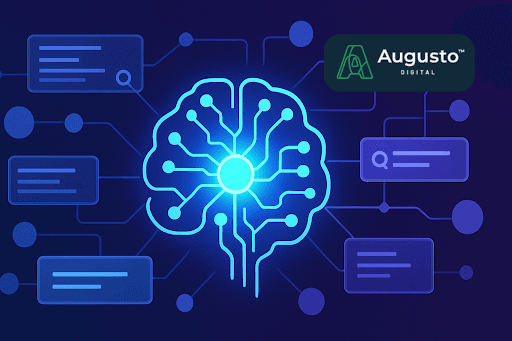The Next Evolution of Search: From Rankings to Mentions
Large Language Models (LLMs) like ChatGPT and Google’s generative AI are transforming how people discover information. Instead of listing links, these tools synthesize answers directly from web content. The result? Traditional SEO isn’t just about being on page one anymore, it’s about being part of the answers AI delivers.
In this new paradigm, being mentioned is the new click. To remain visible and relevant, organizations must adapt their content strategies to be accessible, authoritative, and AI-readable.
Some call this Generative Engine Optimization (GEO) or Answer Engine Optimization (AEO). We call it AI SEO – optimizing for visibility in the era of generative AI. As Search Engine Land and Raptive highlight, the way we optimize for AI-generated search is evolving rapidly.
1. Optimize for AI Inclusion
If AI models can’t access your site, they can’t feature your content.
Open your site to trusted crawlers. Double-check that your robots.txt allows access to Googlebot and AI-related crawlers like OpenAI’s GPTBot. Avoid excessive use of noindex or nosnippet tags unless you handle sensitive data.
Tip: Think of AI crawlers like journalists looking for credible sources. If your site is blocked, your voice won’t be quoted.
Key takeaway: Ensure your content is discoverable by both traditional search engines and emerging AI systems. Accessibility equals inclusion.
2. Structure Content for Direct Answers
AI tools extract concise, authoritative snippets to generate responses. Make it easy for them to find and use your expertise.
Practical ways to adapt:
-
Anticipate real-world questions. Ask what your customers or decision-makers might query, such as “How can manufacturers reduce waste?” or “What are the best ways for nonprofits to automate donor outreach?”
-
Use clear headings and FAQs. Structure pages with Q&A formats or headers that match user intent.
-
Lead with clarity. Start pages with a concise, factual statement or definition, followed by depth and context.
AI reads for clarity. Humans stay for context. Structure for both.
3. Focus on Quality, Authority, and Trust (E-E-A-T)
Even as technology changes, quality content and credibility remain king. AI systems prefer trustworthy sources when synthesizing answers.
How to establish trust signals:
-
Show expertise. Publish data-backed insights, whitepapers, or case studies like the ones Augusto develops for clients.
-
Highlight author credibility. Include bios and credentials for your contributors.
-
Stay consistent. Ensure your brand name, product data, and facts are uniform across all platforms.
-
Build your entity profile. Being recognized in Google’s Knowledge Graph boosts your authority with both users and AI systems.
According to Lumar’s 2025 report on AI search and Search Engine People, maintaining strong E-E-A-T signals is critical to ensure AI-driven platforms identify and trust your content.
4. Leverage Technical SEO for AI Visibility
LLMs thrive on structured, high-performing content. Technical SEO is your bridge between human readability and AI comprehension.
Focus on these fundamentals:
-
Add schema markup (FAQPage, HowTo, Organization, Person) to make content machine-readable.
-
Prioritize speed and mobile optimization since slow sites can cause AI indexers to skip your content.
-
Enable multimodal content. Tag images, videos, and graphics so AI can reference them in generative results.
-
Stay ahead of standards. Emerging files like llm.txt may soon offer specific AI crawler guidance. Adopt early.
Structured data equals structured visibility. Netpeak Agency emphasizes that schema and site performance are foundational to success in Generative Engine Optimization.
5. Measure New AI SEO KPIs
The metrics of SEO success are evolving. Rankings and clicks tell only part of the story. Now, you need to measure:
-
Mentions in AI answers. Tools are emerging to track how often AI platforms cite your content.
-
Referral traffic from AI sources. Bing Chat and Google SGE already link back to sources.
-
Brand awareness lift. Even without clicks, being mentioned by AI assistants can increase search interest and credibility.
Pro tip: Experiment. Test different content structures and measure how often you appear in AI-generated summaries.
If you’re not appearing in AI-generated answers, you’re essentially invisible in the next generation of search.
6. Collaborate Across Teams: SEO Meets Brand and AI Strategy
SEO is no longer a silo. Your brand voice, PR, and AI adoption strategy all influence how AI perceives and surfaces your company.
-
Align with branding and content teams to ensure consistent messaging.
-
Leverage AI tools to analyze content performance and uncover gaps.
-
Integrate marketing, data, and engineering teams to sustain continuous optimization.
AI optimization is a team sport. Collaboration fuels visibility.
Build for Humans, Optimize for AI
AI-powered search is reshaping the digital landscape. The fundamentals still win. Deliver value, build trust, and communicate clearly. Then make it easy for AI systems to find, parse, and reuse your best ideas.
At Augusto, we help organizations embed AI intelligence into their marketing, SEO, and product ecosystems to drive measurable ROI fast. If your team is ready to future-proof your digital visibility, we’re ready to partner.
Let's work together.
Partner with Augusto to streamline your digital operations, improve scalability, and enhance user experience. Whether you're facing infrastructure challenges or looking to elevate your digital strategy, our team is ready to help.
Schedule a Consult

